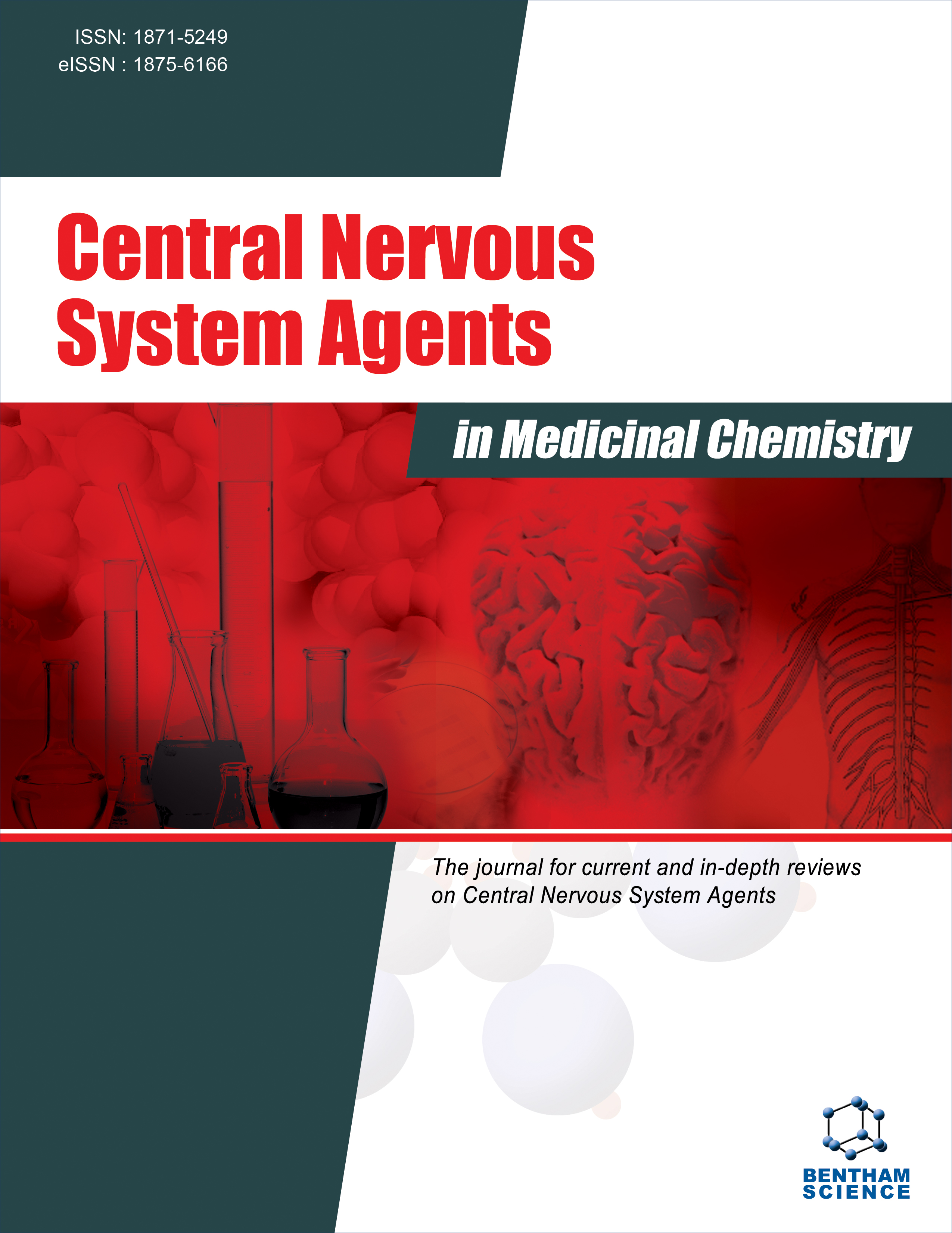- Home
- A-Z Publications
- Central Nervous System Agents in Medicinal Chemistry (Formerly Current Medicinal Chemistry - Central Nervous System Agents)
- Previous Issues
- Volume 7, Issue 4, 2007
Central Nervous System Agents in Medicinal Chemistry (Formerly Current Medicinal Chemistry - Central Nervous System Agents) - Volume 7, Issue 4, 2007
Volume 7, Issue 4, 2007
-
-
Involvement of Uridine-Nucleotide-Stimulated P2Y Receptors in Neuronal Growth and Function
More LessThe uridine nucleotides UTP, UDP and UDP-sugars produce a variety of effects by activating specific G protein- coupled P2Y receptors, i.e., the P2Y2, P2Y4, P2Y6 and P2Y14 variants. Except for P2Y14 which has recently been defined, stimulation of P2Y receptors by UTP and/or UDP augments proliferation of adult multipotent neural stem cells; stimulates dopaminergic differentiation in human mesencephalic neural st Read More
-
-
-
The Neuroprotective Effect of Ginkgo biloba Leaf Extract and its Possible Mechanism
More LessAuthors: Ying T. Mak, Maria S.M. Wai and David T. YewAn extract from the leaves of the Ginkgo biloba tree, labeled EGb761, is one of the most widely used medicinal products in the West for cardiovascular and brain related diseases. In particular, it has been used frequently for the treatment and prevention of neurodegenerative diseases such as mild cognitive impairment or Alzheimer's disease. The drug is relatively safe and has been used widely by healthy indivi Read More
-
-
-
Proteasome Modulation in Brain: A New Target for Anti-Aging Drugs?
More LessAuthors: Michele Mishto, Elena Bellavista, Aurelia Santoro and Claudio FranceschiProteasomes (including constitutive proteasome, immunoproteasome, and their regulatory complexes) are multicatalytic complexes crucial for cell and body homeostasis and survival, being responsible for a consistent part of protein degradation. In the central nervous system (CNS), the activity of proteasomes affects a variety of crucial brain activities. While proteasome alteration (content and activity) during aging has been stu Read More
-
-
-
Inhibition of Rho/Rho-Kinase as Therapeutic Strategy to Promote CNS Axonal Regeneration
More LessAuthors: Mitsuharu Endo and Toshihide YamashitaAfter injury to the central nervous system (CNS) of adult vertebrates, axonal regeneration is extremely limited because inhibitory proteins existing around the injury site prevent the regrowth of the lesioned axons. Previous studies have reported that several myelin-derived proteins (such as Nogo, MAG, OMgp) and developmental guidance proteins (such as RGM, semaphorin, ephrin) contribute to the inhibition of axonal regen Read More
-
-
-
Does Cyclic Dependent Kinase 5 Play a Significant Role in Determination of Stroke Outcome? Possible Therapeutic Implications
More LessAuthors: Mark Slevin, Marta Grau-Olivares, John Gaffney, Pat Kumar, Sajjad Hussain, Shant Kumar and Jurek KrupinskiIschaemic stroke is a leading cause of death and disability in the Western world and usually occurs as a consequence of progressing atherothrombosis resulting in embolism and associated local tissue damage due to loss of cell membrane integrity and altered signal transduction activity. Survival of neurones, particularly in peri-infarcted regions determines the extent of patient recovery. A significant proportion of Read More
-
-
-
Interference of Glycine Transporter 1: Modulation of Cognitive Functions Via Activation of Glycine-B Site of the NMDA Receptor
More LessAuthors: Philipp Singer, Joram Feldon and Benjamin K. YeeThe high-affinity glycine transporter 1 (GlyT1) is the primary endogenous regulator of glycine levels in the vicinity of the N-methyl-D-aspartate receptor (NMDAR). As a co-agonist, glycine can allosterically modulate NMDAR functions through its binding to the glycine binding site (glycine-B site). Under homeostatic conditions, GlyT1 mediated re-uptake is believed to maintain the synaptic glycine concentration below the satu Read More
-
-
-
Nicotinic Receptors and the Treatment of Attentional and Cognitive Deficits in Neuropsychiatric Disorders: Focus on the α7 Nicotinic Acetylcholine Receptor as a Promising Drug Target for Schizophrenia
More LessAuthors: Christian Chiamulera and Guido FumagalliA large body of evidence shows that α7 nicotinic acetylcholine receptor (nAChR) is an important mechanism underlying attentional and cognitive deficits in schizophrenia. Several compounds acting as activators of α7 nAChRs have been identified and investigated for a potential therapeutic application. However, considering the complexity of neuropsychiatric disorders and the difficulty to meet an ideal product profile for dru Read More
-
-
-
Actions of Melatonin, Its Structural and Functional Analogs in the Central Nervous System and the Significance of Metabolism
More LessAuthors: Rudiger Hardeland and Burkhard PoeggelerThe CNS is both source and target of melatonin. It is released from the pineal to the circulation and, in elevated concentrations, into the third ventricle. Levels by 3 orders of magnitude higher than in the circulation have been found in the CNS. The mammalian circadian pacemaker, suprachiasmatic nucleus (SCN), controls the pineal, but is also major subject to feedback information on darkness, transduced by two G- Read More
-
Volumes & issues
-
Volume 25 (2025)
-
Volume 24 (2024)
-
Volume 23 (2023)
-
Volume 22 (2022)
-
Volume 21 (2021)
-
Volume 20 (2020)
-
Volume 19 (2019)
-
Volume 18 (2018)
-
Volume 17 (2017)
-
Volume 16 (2016)
-
Volume 15 (2015)
-
Volume 14 (2014)
-
Volume 13 (2013)
-
Volume 12 (2012)
-
Volume 11 (2011)
-
Volume 10 (2010)
-
Volume 9 (2009)
-
Volume 8 (2008)
-
Volume 7 (2007)
-
Volume 6 (2006)
Most Read This Month
Article
content/journals/cnsamc
Journal
10
5
false
en


